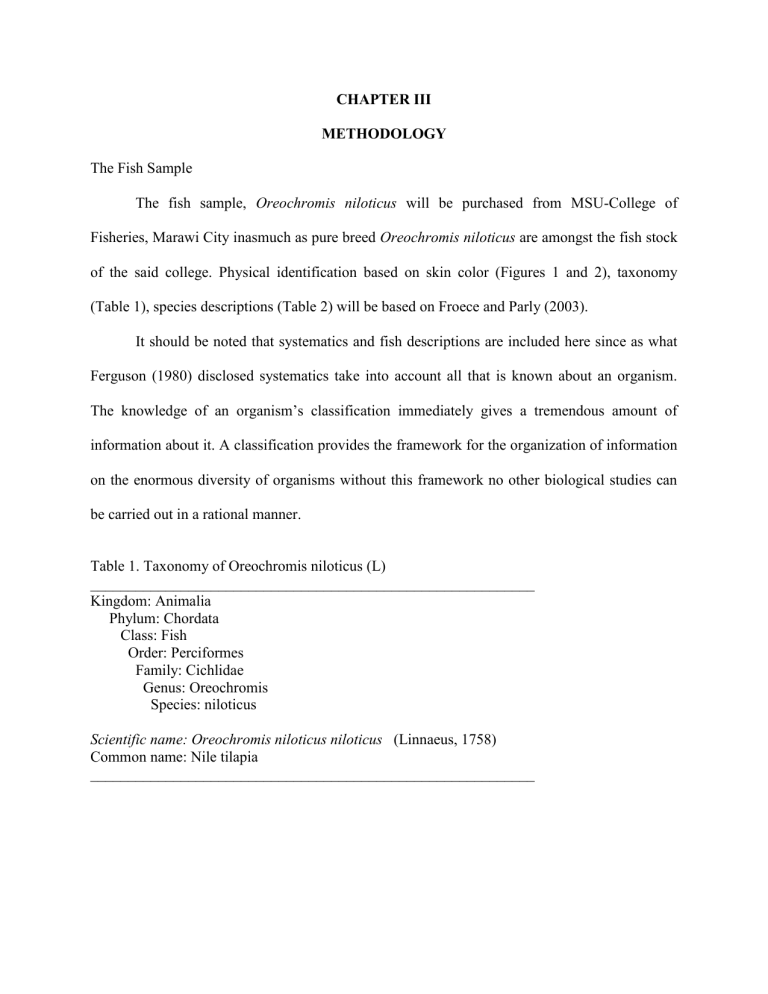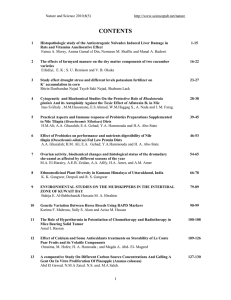CHAPTER III METHODOLOGY The Fish Sample The fish sample

CHAPTER III
METHODOLOGY
The Fish Sample
The fish sample, Oreochromis niloticus will be purchased from MSU-College of
Fisheries, Marawi City inasmuch as pure breed Oreochromis niloticus are amongst the fish stock of the said college. Physical identification based on skin color (Figures 1 and 2), taxonomy
(Table 1), species descriptions (Table 2) will be based on Froece and Parly (2003).
It should be noted that systematics and fish descriptions are included here since as what
Ferguson (1980) disclosed systematics take into account all that is known about an organism.
The knowledge of an organism’s classification immediately gives a tremendous amount of information about it. A classification provides the framework for the organization of information on the enormous diversity of organisms without this framework no other biological studies can be carried out in a rational manner.
Table 1. Taxonomy of Oreochromis niloticus (L)
___________________________________________________________
Kingdom: Animalia
Phylum: Chordata
Class: Fish
Order: Perciformes
Family: Cichlidae
Genus: Oreochromis
Species: niloticus
Scientific name: Oreochromis niloticus niloticus (Linnaeus, 1758)
Common name: Nile tilapia
___________________________________________________________
Figure 1. The Oreochromis niloticus (L)
Figure 2. The scientific illustration of Oreochromis niloticus (L) after
Froece and Parly (2003)
Table 2. The biological descriptions of Oreochromis niloticu s (L)
Size / Weight / Age
Max length : 60.0 cm SL male/unsexed; max. published weight: 4,324 g; max. reported age: 9 years
Length at first maturity
L m
18.6, range 8 - 28 cm
Environment
Freshwater; brackish; benthopelagic; potamodromous; depth range 5 - m usually - 20 m)
Climate / Range
Tropical; 14°C - 33°C; 32°N - 10°N
Distribution
Africa: coastal rivers of Israel; Nile from below Albert Nile to the delta; Jebel Marra; in West
Africa natural distribution covers the basins of the Niger, Benue, Volta, Gambia, Senegal and
Chad, but introduced specimens reported from coastal basins. Widely introduced for aquaculture, with many existing strains. Several countries report adverse ecological impact after introduction.
Short description
Dorsal spines (total): 15 - 18; Dorsal soft rays (total): 11-13; Anal spines: 3; Anal soft rays: 9 -
11;Vertebrae: 30 - 32. Diagnosis: jaws of mature male not greatly enlarged (length of lower jaw
29-37 % of head length); genital papilla of breeding male not tassellated. Most distinguishing characteristic is the presence of regular vertical stripes throughout depth of caudal fin
Biology
Occur in a wide variety of freshwater habitats like rivers, lakes, sewage canals and irrigation channels Mainly diurnal. Feed mainly on phytoplankton or benthic algae. Oviparous.
Mouthbrooding by females. Extended temperature range 8-42 °C, natural temperature range 13.5
- 33 °C Marketed fresh and frozen
IUCN Red List Status: Not Evaluated Threat to humans : Potential pest
The Sampling Procedure, Design, and Milt Collection
The present study will be conducted at the MSU-college of Fisheries, Marawi City
Campus. The milt will be obtained from O. niloticus broodstock(150,200g) held in 120L glass aquaria within a recirculating system at the MSU-College of Fisheries.
Following the protocol of Garcia-Abiado (1995), a 100µl capillary tube will be employed to collect the milt. Prior to milt collection, the fish bladder will emptied by applying gentle abdominal pressure. The genital papilla will be dried with absorbent paper to remove mucus, urine, and faecal material. The capillary tube will be held at the tip of the genital papilla. The fish milt will be drawn into the tube while applying gentle abdominal pressure. The collected fish milt will deposited in a vial and will be placed in a 4C refrigerator.
Saline solutions will be prepared by dissolving calculated sodium chloride (NaCl) crystals (Analytical Reagent) in a corresponding amount of triple distilled water to obtain the desired concentration. For example, a 2 parts per thousand (2ppt) saline concentration will be obtained by dissolving 2g of NaCl in 1000ml triple distilled water in an Erlenmeyer flask. A 4ppt saline concentration will be obtained by dissolving 4g of NaCl in 1000ml triple distilled water and so on and so forth.
The experiment will be consisted of six (6) treatments each will be replicated thrice in a completely randomized design (CRD) as follows:
REPLICATES
1
2
3
0
T1R1
T1R2
T1R3
2
T2R1
T2R2
T2R3
TREATMENTS (in ppt)
4 6
T3R1 T4R1
T3R2
T3R3
T4R2
T4R3
8
T5R1
T5R2
T5R3
10
T6R1
T6R2
T6R3
Each of the collected milt in the vials shall be administered with the various prepared saline concentrations, with the aid of dropper. A few drops of the treated milt with spermatozoa in it will be placed in a glass slide, and will be viewed and examined under a compound microscope, first from low power objective (LPO) and will be shifted to high power objective
(HPO). Observations of sperm motility will be based on the time span sperm is motile.
Observations wills terminate until the spermatozoa stop moving. The time span (in seconds) will be recorded and will be used in data analysis.
Data Analysis
The collected data will be analysed using Systat Version 10.2. Analysis of Variance
(ANOVA) will be used to determine the saline concentration which can prolong the freshwater nile tilapia, Oreochromis niloticus (L) spermatozoa life span. This would be followed by Duncan
Multiple Range Test (DMRT) to determine which amongst the means showed significant difference.











